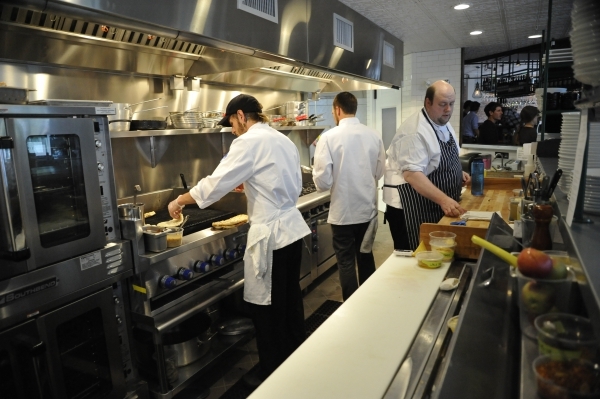BRATTLEBORO — “It's easier to point out what's not local on our menu than to say what is local,” says owner Stephanie Bonin, of Duo's recently released winter dinner and dessert menus.
“Until the frost, about 70 percent of our produce was local,” Bonin tells The Commons, then notes the new seasonal menu at Brattleboro's newest farm-to-table restaurant features “more local than not” ingredients, such as squash and winter vegetables sourced from nearby farms, mostly through the restaurant's relationship with Windham Farm and Food.
“They are the middle person between local farms and restaurants,” Bonin explains.
Cabbage salad, from the dinner menu, isn't on the restaurant's Denver menu, Bonin says, referring to Duo's original location. She says she gets to offer it in Brattleboro because she found what she calls a good, local source of cabbage all winter: Harlow Farm.
In addition to its namesake vegetable, Duo's cabbage salad includes currants, blue cheese, and caraway seeds, and is dressed with red wine vinaigrette.
Kohlrabi, another locally sourced vegetable available after the frost, is gratinéed and served with the Vermont beef entrée.
Bonin notes the importance of sourcing protein locally, too, and credits Putney's Horsenettle Farm as the source of the pasture-raised rabbit starring in the smoked rabbit appetizer, which is served here with celeriac purée and rosemary oil.
From the new dessert menu, Bonin singles out Banoffee pudding, an English recipe that she says surprises customers “because pudding is not normally thought of as special.”
Duo, Bonin says, offers with this a layer of housemade toffee and a layer of fresh bananas, and the treat has become quite popular in the few weeks since the menu appeared.
Another feature Bonin says she hopes will catch on is Community Night, an idea Bonin conceived of long ago and could only make happen in Brattleboro. Her Denver location is too small, she says.
Another invention: Beginning in January, every Tuesday at 6 p.m., Community Night invites diners - regardless of the number in their party - to sit together at the big table in the restaurant's westernmost room and enjoy a prix fixe, three-course menu, some of which will be served family-style.
“There might be a big bowl of something placed in the center of the table, but there may be also individual bowls of soup, or special crostini each diner gets on their individual plate,” Bonin says.
The room itself promotes community, and not just because of its generous, communal table: The ceramic plates hanging in a free-form array on the southern wall were created for the restaurant by local potter Stephen Procter, a longtime friend of Bonin's family.
Bonin has known Procter since she was a girl. He was a friend of her parents, back when they owned The Book Cellar on Main Street, just a few doors south of Duo.
The western wall, high up in the corner, holds a remnant of the Colonial-era mural last seen when Duo's High Street location housed the old Pickwick Room and the Corner Café. This treasure was uncovered during renovations.
Other upcoming events include December holiday dinners, featuring foods not found on the regular menu.
“For Christmas Eve, we'll have a three-course prix fixe dinner with choices for each course,” Bonin says. For New Year's Eve, Duo offers three seatings for that night's prix fixe dinners, with the first containing three courses and the second and third seatings offering four courses for slightly more.
Duo's menus - the main, seasonal ones, as well as those for special events and holidays - come from a collaboration between Bonin, her husband, Keith Arnold, Executive Chef Tyler Skrivanek, Chef de Cuisine Andrew Hunter, and Sous Chef Tiffany Leong in Denver.
“Credit for the recipes needs to go to my executive chef [Skrivanek],” Bonin says, but boasts everyone in management has a hand in creating the direction of the restaurants' cuisine.
“What creative people thrive on is having the opportunity to be creative,” she says.
The winter menu offers braised meats and rich, warm, comforting dishes, Bonin says. She also eagerly anticipates the transition into the next season - well, setting aside mud season, which is best ignored from a culinary standpoint.
Moving into spring marks the most amazing of shifts, she says, “because we start craving what's becoming available: soups, [and] creamy polenta with meat. […] Winter to spring proves that seasonal eating is our natural way to eat.”
